Term 3 Chapter 3 | 4th Science - Air We Breathe | 4th Science : Term 3 Unit 3 : Air We Breathe
Chapter: 4th Science : Term 3 Unit 3 : Air We Breathe
Air We Breathe
Unit 3
AIR WE BREATHE

Learning Objectives
After the completion of this unit students will be able to
• know that air is a mixture
• understand the composition and components of air
• explain air pollution and its effects
Introduction
Our earth is made of land, water,
and air. All three components are very much important for the survival of all
living creatures. Air is present all around us and is very important for our
lives. It is very important to cause rain and for the growth of crops. It is
needed for the respiration of plants and animals.
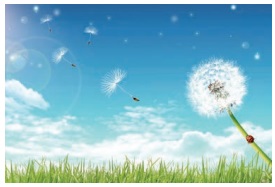
ACTIVITY
Take a squeezable
bottle. Make a hole on the lid and close the bottle tightly. Bring the bottle
near your face and press the bottle. What do you feel?

Importance of Air in Our Daily Life
1. Oxygen present in air is needed for respiration.
2. We can speak and hear the sound only when there is air around.
3. Air helps in the dispersal of seeds for plant reproduction.
4. Monsoon and rain occurs due to the wind action.
5. Air regulates the atmospheric temperature.
Let us do
Tick the objects
which have air in them.
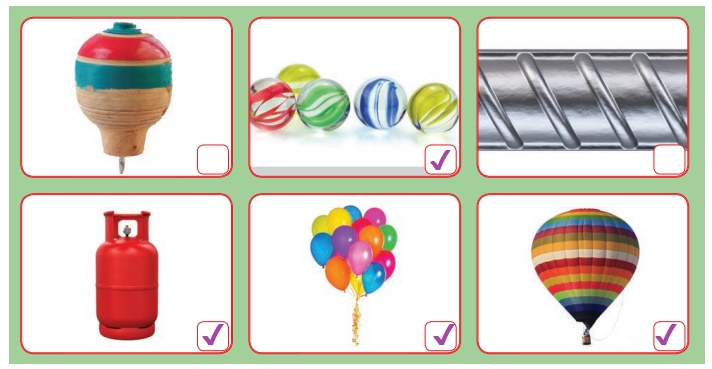
Air is a Mixture
The air we breathe consists of a
mixture of gases. It contains solid and liquid particles too. Air can be
separated into its constituents such as oxygen, nitrogen etc. Water vapour
mixes with air and becomes a part of it. Air also contains dust and smoke. Air
shows the properties of all the gases present in it. E.g. Air supports
combustion because of oxygen present in it. While cooking using firewood,
fanning air helps in burning of fire wood.
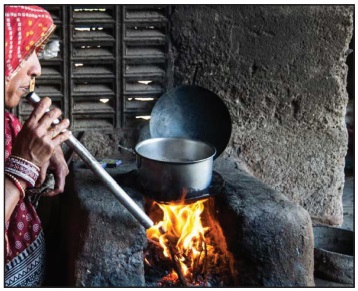
Do you Know?
How do we get cool water from a clay water pot on
hot sunny days?
Clay pot has thousands of tiny pores through which
water seeps out. This causes cooling effect.
Let us do
Tick the object
which gives out water vapour.

Do you Know?
The nathaswaram and the flute are some of the
examples for wind instrument.
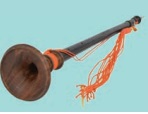
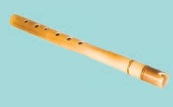
Composition and components of air
The composition of air is not
constant. It varies from place to place and over time.
Air is
not a single element; it is made up of different substances.
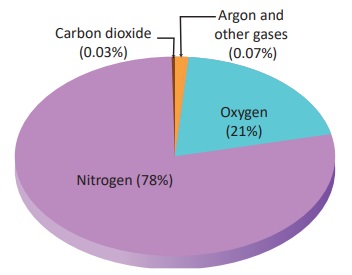
Activity
Write the
percentage of the gases present in air.
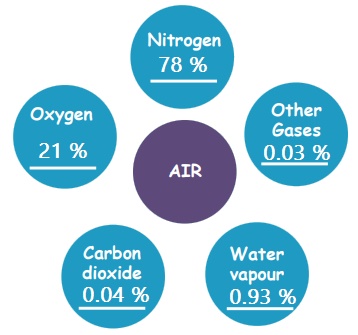
Nitrogen
The amount of Nitrogen present in
air is about 78%.
It is used to fill up food
packages to extend their shelf life.
Liquid nitrogen is used to store
living cells.

Plants need nitrogen for their
growth. We can see root nodules containing nitrogen in some plants.
Nowadays people use nitrogen gas to fill the tyres of their vehicles. Some compounds of nitrogen are used as explosives also.
Do you Know?
In 1772, the Scottish chemist, Daniel Rutherford,
reported “noxious air,” which now we call “Nitrogen”.
Activity
You might have seen
some huge colourful balloons flying high in malls. Those balloons are filled
with nitrogen gas. Write the reason for filling nitrogen gas in balloons.
Nitrogen is an
inert gas. It is similar to air but it is slightly lighter than air. So when
there is no necessity to lift the balloon very high, we use nitrogen gas.
Oxygen
It is one of the main components
of air. The amount of Oxygen present in air is about 21%. All the creatures
cannot live without oxygen. It can be tested with a piece of glowing splint,
which relights in oxygen.
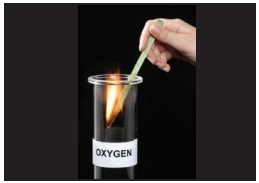
Uses of oxygen
1. All living things use oxygen for breathing.
2. Oxygen is essential for burning.
3. Oxygen cylinders are used in hospitals to enable the patients to
breathe when they cannot breathe normally.
4. Oxygen is used in gas welding.
Do you Know?
Mountaineers carry oxygen cylinders at high
altitudes.
Deep sea
divers also carry oxygen cylinders along with them while diving deep into the
sea.

Carbon dioxide
The amount of carbon dioxide
present in air is only 0.03%. Though it is less in percentage its uses are more
and essential. It can be tested with lime water. The lime water changes from
colourless to milky.
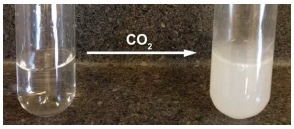
Uses of carbon
dioxide:
1. Carbon dioxide helps plants in photosynthesis.
2. It is used in fire extinguishers.
3. It is used in refrigerators as dry ice for cooling purposes.
4. It is used to make plastics and polymers.
Do you Know?
The Scottish chemist Joseph Black discovered that
carbon dioxide is present in air.
Air has other gases like
hydrogen, helium, argon etc. in small proportion. Air also contains water
vapour which varies according to the environment. When we breathe, we take
oxygen from air and release carbon dioxide and water vapour to air.
ACTIVITY
Classify the
following.
( Dog, cat, coconut
tree, monkey, brinjal plant, papaya plant)

Do you Know?
A grown up tree intakes 1/3 of carbon dioxide
exhaled by one person and it gives out the same amount of oxygen required by a
person. Hence, three trees are needed to fulfill the required oxygen for a man
to survive.
Air pollution
The atmospheric balance is
disturbed by human activities. This leads to environmental problems like air
contamination and global warming. The air carries soot, smoke, and other particles
from car exhaust and power plants. These are the major contributors to air
pollution.
Activity
Look at the path of
light rays entering through window of your home/school. You can see lot of tiny
particles suspended and moving in the air. These are dust particles. You can
also test the same with the help of a torch light in darkness.

Do you Know?
Covering our mouth and nose while sneezing or
coughing prevents spreading of germs through air to people around us.
Adverse effects of
air pollution
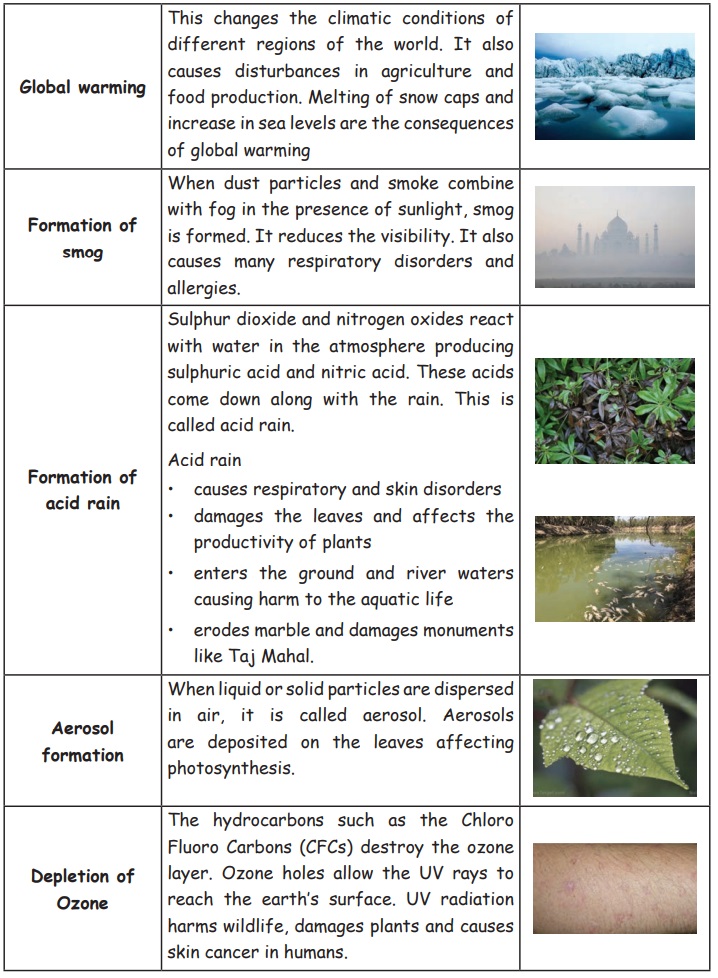
Activity
Tick![]() the causes
of global warming
the causes
of global warming

Effects of air
pollution on human beings
Air pollution has bad impact on
human health. When the pollutants increase in air, they cause irritation in the
eyes, nose and throat. Air pollution can also produce wheezing, coughing and
breathing problems in humans.

Some of the major effects of air
pollution on human beings are:
1. Respiratory diseases. E.g. Flu, Tuberculosis
2. Cardiovascular damage.
3. Fatigue, headaches and anxiety.
4. Nervous system damage.

Activity
• Go by walk
or use a bicycle to nearby places.
• Plant more
trees.

Steps to check air
pollution
Air pollution can be reduced by
the following steps.
1. Alternative source of energy (E.g. Solar energy) should be used.
2. Air filters should be used to prevent harmful gases mixing with air.
3. Smoke emission test and certification of motor vehicles must be
enforced.
4. More trees should be planted to absorb carbon dioxide.

Do you Know?
Alternative source of energy are Solar Power,
Nuclear Power, Hydroelectric Energy, Wave Energy, Biofuels, Natural Gas,
Geothermal Power, Wind Energy, Biomass Energy, Tidal Energy and Hydrogen Gas
Activity
Write slogans on
harmful effects of air pollution in a chart and stick it on the display board
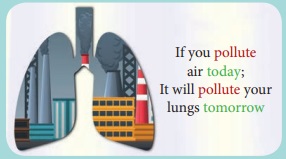
1. Polluted air, harms our heir.
2. Pollution kills, brings all ills
3. Smoke and fog like rabid dog.
4. Bike race thrills but pollution kills.
Related Topics